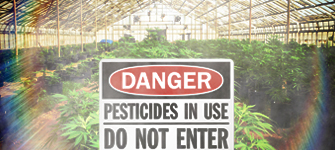Recently there has been major concern about the use of pesticides on marijuana plants. Major news outlets like the Cannabist, Huffington Post and many more are talking about the questions that need to be asked: Are pesticides harmful? What types of pesticides are being found? Why is it difficult to determine whether a grow is using pesticides and whether those pesticides are harmful?
To better understand these questions, it’s necessary to look into the history of pesticides and pesticide use. The definition of “pesticide”, according to James Tano Zacharia, is:
any substance or mixture of substances intended for preventing, destroying, or controlling any pest including vectors of human or animal diseases, unwanted species of plants or animals causing harm during, or otherwise interfering with, the production, processing, storage, or marketing of food, agricultural commodities, wood and wood products, or animal feedstuffs, or which may be administered to animals for the control of insects, arachnids or other pests in or on their bodies.
This thorough definition emerged after the first generation pesticide became a major health risk. Highly toxic chemicals such as calcium, lead arsenate and certain types of cyanide were used to control pests like fungi, bacteria and insects. After realizing the incredible threat of these harmful chemicals, The Green Revolution came into effect in 1944.
The Green Revolution was a global agricultural movement to boost grain yields that were quickly deteriorating due to the rapid growth of human population. Because of the Green Revolution, extensive research and radical changes have been made toward the study of safe pesticides for produce and consumers. The word pesticide was understood to be an umbrella term that covered multiple types of specific pesticides, some harmful, some not.
So what does this mean for the cannabis industry?
The big picture problem is a bit more complicated than a one-solution, fix-all approach. One issue is the lack of standards and impossibility of testing multiple batches that may contain pesticides. Another factor is the expense. According to a 2015 Oregon study, Cannabis growers need to be prepared for the costly testing that will ensure their products are completely safe.
The study explains issues Oregon faced when using pesticides they had no idea were harmful or not. The study blatantly lays out the big picture problem, saying “growers had no guidance as to what they could use, independent Cannabis testing labs (ITLs) had no guidance on what to test for, and consumers were given products with labels that implied they were “pesticide-free". These labels were generally misleading.”
Washington and Colorado learned from this entropy, but were at a standstill as to how to move forward. Both states introduced programs to accurately establish ITLs, but there was still confusion about which tests the labs should perform and what standards the ITL’s should be held to.
After understanding the big picture problem, real discussion has been about which methods are best for testing pesticides and some organization was put into action. Shifty guidelines called the Scope of Accreditation written up by the International Organization for Standardization (ISO) include five major points for moving forward:
- Cannabis testing labs must be certified to ISO standard
- There must be a third party to assess and credit the lab being tested
- Testing labs must include any public health implications on their scope of accreditation (e.g. pesticides, microbiology, residual solvents and water activity)
- Testing labs must pass testing programs that cover all methods that have public health implications
- Testing labs must be managed by a full-time on-site chemist with a PhD and at least 8 years of experience.
People can agree that this is a big step forward in the eradication of harmful pesticides used on cannabis, but there are still many holes. For example, what type of testing programs will test the labs? What makes these programs more credible than the lab itself? What happens when quality is not “up to standards"? What are the consequences?
The absolute certainty of safety against harmful pesticides is still a long way off. But with forward movement and public awareness, we could see major advancement within this area of the cannabis industry very soon.











